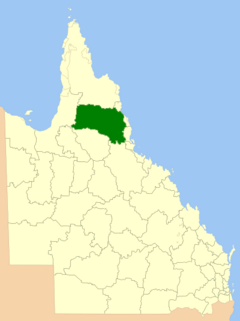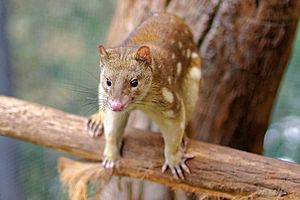Windsor Tablelands facts for kids
Quick facts for kids Windsor TablelandsQueensland |
|||||||||||||||
|---|---|---|---|---|---|---|---|---|---|---|---|---|---|---|---|

The Windsor Tablelands are located within the greater Tableland region Queensland, 2013.
|
|||||||||||||||
| Area | 48,930 ha | ||||||||||||||
| Region | Far North Queensland | ||||||||||||||
| State electorate(s) | Cook | ||||||||||||||
| Federal Division(s) | Kennedy | ||||||||||||||
| Website | Windsor Tablelands | ||||||||||||||
|
|||||||||||||||
The Windsor Tablelands are a group of flat, high areas of land called plateaus. They are found in Far North Queensland, Australia. This special area is part of the Wet Tropics of Queensland, a famous rainforest region. It sits between the amazing Daintree Rainforest and Mount Lewis National Park.
The Tablelands are also part of the larger Tablelands Region in North Queensland. They are close to the Great Dividing Range mountains. The nearest town is Wujal Wujal, about 44 kilometers away. Most of the Windsor Tablelands is a protected area called Mount Windsor Forest Reserve. It became a conserved nature area in 2005. This means it is mostly closed to the public to protect its plants and animals. No one lives in the Mount Windsor Tableland region because it is a national park.
Contents
What are the Windsor Tablelands like?
The Windsor Tablelands cover a total area of about 489.3 square kilometers. They have many different types of natural environments. You can find wetlands, thick rainforests, and mountain ecosystems here. Even though it's part of the Wet Tropics, some areas also have open forests and dryland forests.
How high are the Windsor Tablelands?
The Tablelands are the sixth highest place in Queensland. They are usually about 1186 meters above sea level. The height of the plateaus themselves can vary from 90 to 120 meters. Because they are so high, the peaks are often hidden by clouds or thick fog. This misty weather is common in the humid Wet Tropics of Queensland.
Water and weather in the Tablelands
The landscape includes not just forests but also many running streams and waterfalls. These water bodies are full of aquatic life. Another nearby plateau is the Mount Carbine Tableland. It is similar in its geography and is also part of the Wet Tropics of Queensland World Heritage area.
The area gets a lot of rain, especially in January and February. These are the summer months. Less rain falls during the winter months in the middle of the year. Records from 1950 show that the annual rainfall is usually more than 1 meter. Sometimes, it can even be over 4 meters! The average rainfall is around 2.3 meters per year.
Why are the Windsor Tablelands important?
The Windsor Tablelands are a protected natural area. They are mostly part of the Mount Windsor National Park. This park is also part of the Wet Tropics of Queensland. The traditional owners of this land are the Western Yalanji people.
The Tablelands became a protected area on December 22, 2005. This happened because of the many different plants and animals that live there. It was recognized as a very important wilderness area. Before it became a national park, people used the area for tin mines and timber. There were also some small cattle farms operating there.
Protecting the Wet Tropics: Protests and change
Before the Wet Tropics of Queensland became a World Heritage Site in 1988, parts of the Windsor Tablelands were being used for roads and tourism. People were also cutting down trees for timber and using other natural resources. Logging had been happening in North Queensland since the 1860s.
However, in the 1980s, people started to protest against these activities. These protests gained a lot of attention. The Daintree blockade was very important for getting the Wet Tropics recognized as a UNESCO World Heritage Site. But the Mount Windsor blockade was one of the first protests. It happened in 1981 to stop extensive logging in the Windsor Tableland. Even though protestors were arrested, their efforts helped bring attention to the issue. This led to more protests for the Wet Tropics of North Queensland.
It took until 2005 for the Windsor Tableland region to become a nationally protected area. But the protests at Mount Windsor and in the Daintree region helped lead the way. They showed how important it was to protect these amazing rainforests and natural places in North Queensland.
How logging affected the Tablelands
Before it was protected, the Mount Windsor Tableland region was heavily logged for its timber. The rainforest was seen mainly for its economic value. The importance of the Tablelands as a home for diverse wildlife and plants was often overlooked.
To get to large areas of valuable trees, bulldozers would clear paths. These logging tracks caused a lot of damage. They were often meters wide and several kilometers long. Streams and water bodies were filled with dirt and debris from the construction and movement of vehicles. It could take years for the water to clear up again. This logging also caused a huge loss of rainforest and woodland cover. Losing the forest canopy makes rainforests weaker. It also harms the animals that depend on these ecosystems. Most of the logging in the Mount Windsor Tableland was for selling timber.
Logging also affected animal species. A study by the CSIRO found that logging in the Mount Windsor Tableland rainforest led to fewer migrating and native birds. They tracked three types of bowerbirds: the Golden Bowerbird, Satin Bowerbird, and Tooth-billed Catbird. The study showed that logging caused these birds to be displaced. This meant they had to move from their homes.
Animals of the Windsor Tablelands
The Mount Windsor National Park is home to 284 different animal species. The Tablelands have many flowing streams, which means they have lots of aquatic animals. These include crayfish, platypuses, and tadpoles that grow into local Carbine Barred Frogs. Many other water animals live here that are unique to the high-altitude Tablelands.
Some mammals, like the Daintree River Ringtail Possum, are very rare. They can only be found in the Mount Windsor Tableland and two other places: the Daintree Rainforest and the Mount Carbine Tableland. Because it is a conservation area, the Windsor Tablelands protects many vulnerable, endangered, and critically endangered species. These animals are monitored by the Queensland Government. They have plans to increase protected areas and create nature refuges. These efforts help bring animal numbers back to safe levels.
Endangered animal species
The spotted-tailed quoll (northern subspecies) is a meat-eating mammal that lives in the Windsor Tableland. It is also called the tiger quoll or tiger cat. The Northern bettong is another endangered mammal found in North Queensland and the Tablelands. This small, rabbit-sized animal lives mainly in the Windsor Tablelands, Coane Range, and Lamb Range. The Northern quoll is also an endangered mammal here.
Many amphibians are endangered and unique to the Windsor Tableland. These include the waterfall frog, common mist frog, and Australian lace-lid.
Critically endangered animal species
An animal is called critically endangered if it is at a very high risk of becoming extinct soon. Only one animal native to the Windsor Tablelands has this critical classification: the little waterfall frog. A deadly fungus called Chytridiomycosis has caused the numbers of these frogs to drop. The Queensland government is trying to help these frogs recover. They are closely watched in areas like the Windsor Tablelands.
Birds protected around the world
The Tableland area has many different bird species. Some are native to the area, and others are protected by international agreements because they migrate. Three birds that migrate through the Mount Windsor Tableland region have international protection. The Convention on the Conservation of Migratory Species of Wild Animals, or Bonn Convention, protects them. These birds are the black-faced monarch, spectacled monarch, and rufous fantail. This convention makes sure that all regions these birds visit, including the Mount Windsor Tablelands, work together to protect them. While these birds are not endangered, their numbers are monitored in the Tableland region.
Plants of the Windsor Tablelands
The Mount Windsor National Park has 1103 different species of plants and fungi. Recent records show that 8 species of plants and fungi are considered vulnerable. This means they are at risk of becoming endangered.
The Red-Throated Bloodwood (Corymbia Rhodops) is a 'vulnerable' plant found in the Wet Tropics of Queensland, especially in the Windsor Tablelands. Another plant, Phlegmariurus Lockyeri, is a tassel fern that is also 'vulnerable'. These plants often grow on rocks and other plants. They grow best in high-altitude rainforests like the Mount Windsor Tableland. In the past, mining was a big threat to this species.
The Cypress Orchid or Thin Feather Orchid (Dendrobium callitrophilum) is a flowering orchid. It lives in the wetland and rainforest parts of the Tableland region and is also classified as vulnerable. The plants of the Windsor Tablelands are protected because the area is a National Park and part of the Wet Queensland Tropics World Heritage listing. However, past logging and mining activities caused many plants, including those listed, to become vulnerable and damaged.



